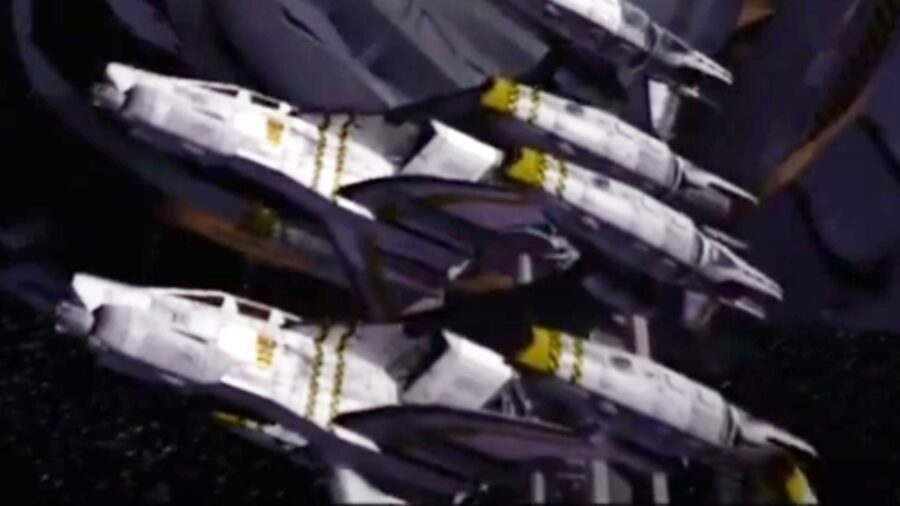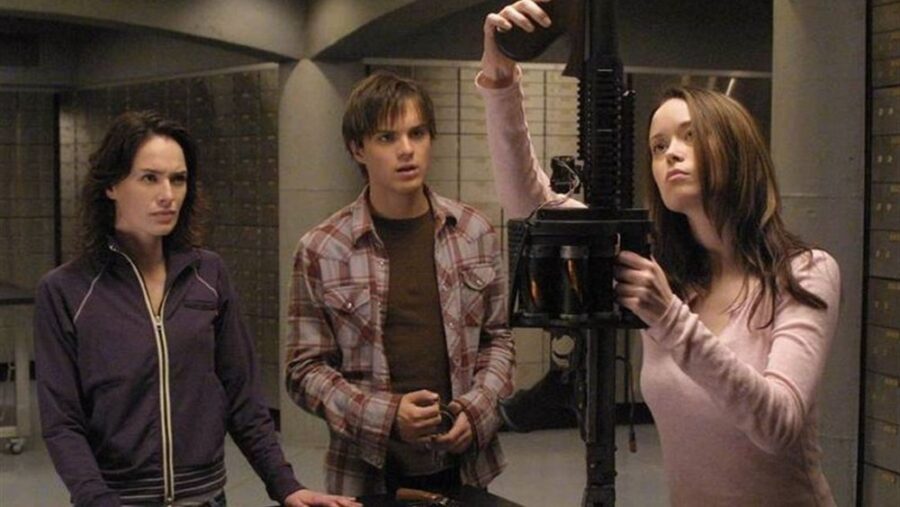The Sci-Fi Series That Deserve A Comic-Book Resurrection

To say that sci-fi series get the short end of the stick from networks and studios is an understatement, with even the most successful of them fighting to stay on the air. in the end, there are a lot of fan bases that have been left wondering what happened to their favorite characters. That’s where the sci-fi comic book series comes in, as it’s a great way for creators to finish the story away from the constraints of a budget or meddling executives. While not every series deserves to come back, for example, not a lot of people are clamoring for a return to the world of V after the events of “Mother’s Day,” there are a few that we’d love to get lost in one more time.
There’s even precedent for this, from the successful Marvel Star Wars line to the various Joss Whedon comics. At this point, Firefly has existed for hundreds of times longer as a sci-fi comic book series than it did as a network show. Even Dollhouse received a follow-up comic book series, but it’s not just the Whedonverse that’s benefitted, as fan-favorite, early-cancelation poster child Jericho was able to finish the story years later. And, of course, if Farscape can pick up where The Peacekeeper Wars left off, we think these shows can do it, too.
Space: Above And Beyond (1995-1996)

Tragically cut short by Fox, Space: Above and Beyond was far too ambitious for its network time slot, as this show told the tale of the “Wildcards” squadron of Marine pilots as they struggle to push back the insectoid Chig following an assault on a human colony. Involving humans, aliens, silicates (artificial intelligence drones that rebelled against their creators), and In Vitroes (genetically engineered soldiers), there was no one way for the whole story to be told in one season. This is true, as creators Glen Morgan and James Wong (known for their work on some of The X-Files early season standout episodes) had a five-year plan.
A military sci-fi comic book series taking fans along the remaining years of their plan would, even now, find an audience, as Space: Above and Beyond is the type of cult hit that’s always creating new fans. The series finale has left fans on a tragic cliffhanger for decades, with most of the Wildcards presumed killed in action, so what happens to them? Do the Chigs have a secret plan behind their offer for peace?
For a one-and-done mid-90s sci-fi series, Space: Above and Beyond has a world still worth exploring today, especially given the relative lack of military sci-fi shows. But by transferring to a sci-fi comic book series, the dated special effects behind the ships and aliens could look as amazing on paper as they do in the minds of fans when they imagine the continuing adventures of the Wildcards.
Crusade (1999)

Crusade, a spin-off of Babylon 5, was, on paper, a very different series from what TNT decided to air, thanks to network interference. The show, following the defeat of the Shadows, sees the population of Earth poisoned by the ancient races’ allies, and so the crew of the Excalibur is off on a race against time to find a cure. Originally, this was supposed to be more about galactic archaeology and plumbing the secret depths of the universe, and while the show we got has parts of that, it was still a let-down.
Thankfully, Crusade’s creator, J. Michael Straczynski, is no stranger to writing a sci-fi comic book series, from his own Babylon 5 series to Marvel’s Fantastic Four, and we’ll forgive him for writing the infamous Spider-Man “One More Day” story arc. Of all the shows on this list, this is the one we’re surprised hasn’t happened yet. After all, the show did leave plenty of dangling plot threads, and given how intricately the original series was plotted out before the first day of shooting, JMS has to have the entire story already planned out.
Deep space Indiana Jones is, as Marvel proved with their Doctor Aphra sci-fi comic book series set in the world of Star Wars, a license to print money, so maybe some day.
Surface (2005-2006)

Surface is going to be a controversial inclusion, as the NBC series that followed the success of Lost was never a hit, and if it developed a fan base, they’ve been relatively quiet. Yet stories about massive monsters lurking under the surface of the ocean are always fun, and the world of this one-and-done series that only lasted 15 episodes was still being set up when it came to an end. The final episode proves that the show was going to be impossible to do justice on a network budget, and that’s why a sci-fi comic book series is the ideal continuation.
The story went from mysterious creatures of the adorable and man-eating varieties to including clones, a government cover-up, and a strange expedition to parts unknown. Surface was, again, a Lost-style mystery box series, so the answers to all the questions it raised may have never existed, but if they did, this could be a fun sci-fi comic book limited series.
After the final moments of the show went off the air, how did the world respond to the cataclysmic change? We may never know, but for such a short-lived show, Surface raised a lot of fascinating questions.
Journeyman (2007)

Another series that was planned to go for longer than the half a season it received, Journeyman is about Dan Vasser, a man who finds out he can travel through time and correct the mistakes of the past. Later, he finds out he’s not alone; other time travelers exist, including his supposedly dead fiancee, Livia, who travels forward through time (starting from 1948). A sci-fi comic book series could do justice to the show’s mysteries and the climax of the story, which we know about from interviews with creator Kevin Falls.
Falls explained he knew the ending of the series would involve everyone Dan had saved being involved in some way, likely as part of an elaborate Rube Goldberg scenario, which would explain why he was sent to help these specific people and, ultimately, the reason he was sent on the journey in the first place. A sci-fi comic book series would, free from the constraints of a live-action network budget, be able to send Dan on more elaborate journeys through time and ultimately allow for a much more elaborate and complex finale.
Mostly, though, we want some answers as to why multiple time travelers exist, why some move in different directions, and what could be such an Earth-shattering scenario that it requires time travel. As with most of these other shows, Journeyman might not have ever, even in a perfect world, finished the story.
Terminator: The Sarah Conner Chronicles (2008-2009)

Terminator in theaters has been hit or miss, with, unfortunately, more miss than hit, but on the small screen, The Sarah Conner Chronicles, starring Game of Thrones’s Lena Headey and Firefly’s Summer Glau, was a hit. Lasting two seasons on Fox, the series had fun playing with the franchise’s mythology, including a cliffhanger ending that had John Conner arrive in a future that had never heard of him. To say fans were a bit disappointed at the show’s cancelation and the lack of resolution to the cliffhanger would be an understatement.
So far removed from that final episode, it would be impossible to continue the story with the same live-action cast, so if Terminator: The Sarah Conner Chronicles is to live again, it would have to be as a sci-fi comic series. Thankfully, there’s been a lot of Terminator comic series, from the original 1988 series to Dark Horse in the 90s and even Marvel’s official Terminator 2 tie-in.
We know that Terminator: The Sarah Conner Chronicles Season 3 would have included John developing a relationship with Allison, the woman that his Terminator protector was modeled on, but as for how the future timeline storyline was resolved, well, no one knows. Again, given the lack of success in theaters, the change to a print medium may be for the better.
FlashForward (2009-2010)

Another network sci-fi show chasing the success of Lost, FlashForward, started with a major mystery: Why did everyone lose consciousness for two minutes and seventeen seconds and see themselves exactly six months in the future? Well, not everyone saw themselves; some saw only darkness, which they assumed meant that they would be dead by then. Regardless, it was a captivating mystery, but as the show was canceled after one season, we never received a satisfying answer.
FlashForward’s creator, David S. Goyer, the visionary who would go on to helm Foundation and The Sandman, explained that eventually, they would find an ancient device that predicted the “flash-forwards” and the last one would go three days into the future….but only 17 people would see the future vision. That left open the question of what happened to everyone else. This premise is begging, even today, for a sci-fi comic series that can wrap up the story.
The novel that the series is based on by Robert J. Sawyer ends with a very bizarre twist that, again, there is no way a network budget could properly support. It’s unlikely that the series would have used that ending, but thanks to a revival as a sci-fi comic book series, a different, less philosophical, and mind-bending ending could be explored. Or keep that one, and do it justice, that’s the beauty of the comics.












